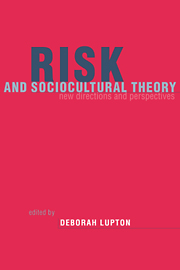Book contents
- Frontmatter
- Contents
- List of contributors
- Introduction: risk and sociocultural theory
- 1 Postmodern reflections on ‘risk’, ‘hazards’ and life choices
- 2 Fear of crime and the media: sociocultural theories of risk
- 3 Risk and the ontology of pregnant embodiment
- 4 Risk anxiety and the social construction of childhood
- 5 Constructing an endangered nation: risk, race and rationality in Australia's native title debate
- 6 Risk, calculable and incalculable
- 7 Ordering risks
- Index
4 - Risk anxiety and the social construction of childhood
Published online by Cambridge University Press: 16 September 2009
- Frontmatter
- Contents
- List of contributors
- Introduction: risk and sociocultural theory
- 1 Postmodern reflections on ‘risk’, ‘hazards’ and life choices
- 2 Fear of crime and the media: sociocultural theories of risk
- 3 Risk and the ontology of pregnant embodiment
- 4 Risk anxiety and the social construction of childhood
- 5 Constructing an endangered nation: risk, race and rationality in Australia's native title debate
- 6 Risk, calculable and incalculable
- 7 Ordering risks
- Index
Summary
Introduction
The theorization of risk and risk anxiety has, so far, paid scant attention to issues of gender and generation. In particular, there has been little work on childhood in this area, despite the pervasiveness of public anxiety about risks to children. In our everyday world generalized risks, of the kind Beck (1992) associates with the democratization of risk, are deemed more pernicious when they threaten children's wellbeing. This is evident in responses to a range of ‘risks’ from concerns about food contamination and disease transmission to the threat of violence. The intensity of public anxiety about dangers to children is most marked in extreme and dramatic circumstances, as in the media response to the shooting of sixteen children in the Scottish city of Dunblane in March 1996. Yet the reaction is equally intense when threats come from children, for example when a child commits a violent crime. This is not as paradoxical as it seems for, as we will argue in this chapter, it is not only children who are perceived as being ‘at risk’ but the institution of childhood itself. Childhood is increasingly being constructed as a precious realm under siege from those who would rob children of their childhoods, and as being subverted from within by children who refuse to remain childlike. Our focus here is on risk and risk anxiety in relation to children and, more specifically, on the sexualization of risk and the consequences of this for children's daily lives.
We take it as axiomatic that childhood is socially constructed and that central to this construction is the imputation of ‘specialness’ to children (as particularly cherished beings) and childhood (as a cherished state of being).
- Type
- Chapter
- Information
- Risk and Sociocultural TheoryNew Directions and Perspectives, pp. 86 - 107Publisher: Cambridge University PressPrint publication year: 1999
- 92
- Cited by



